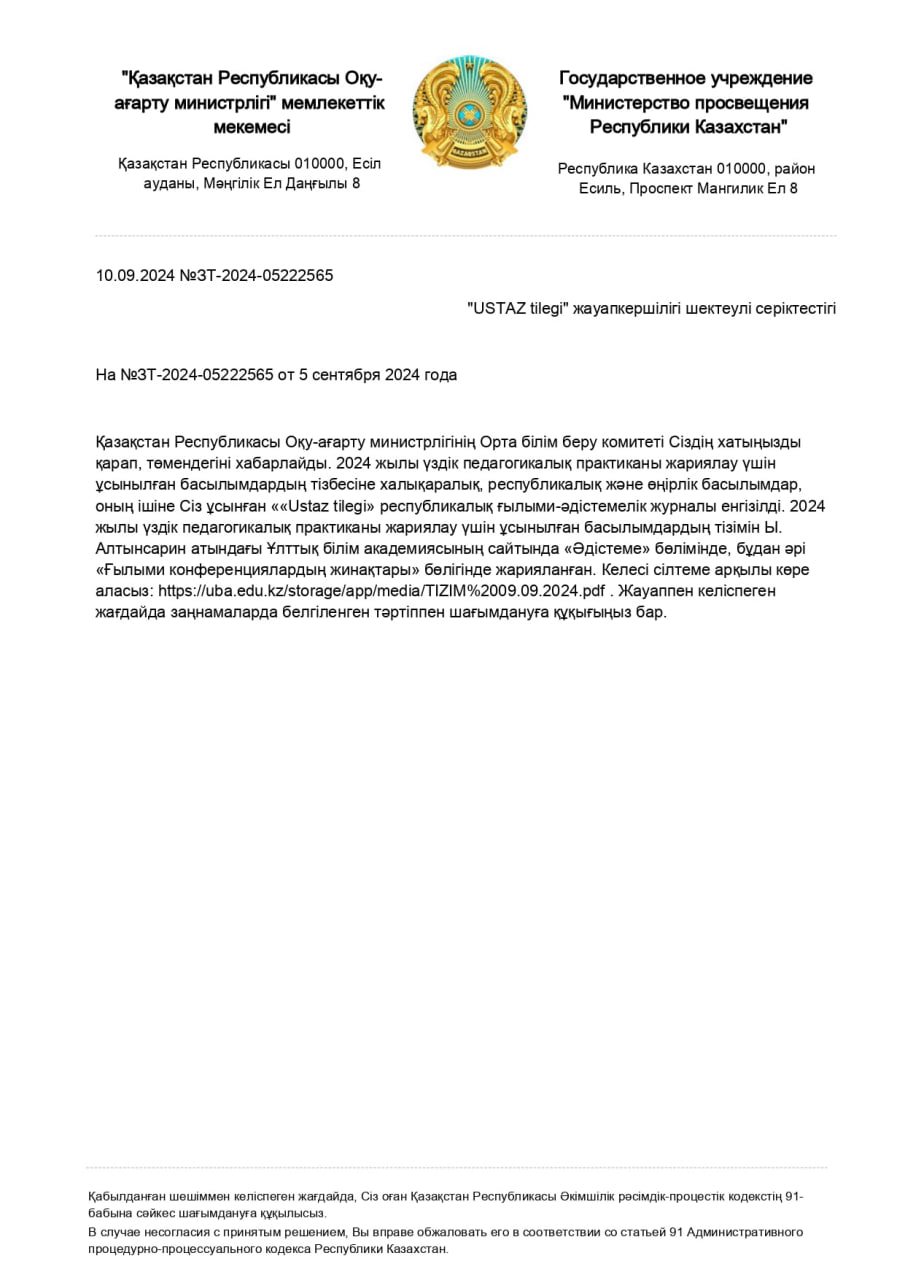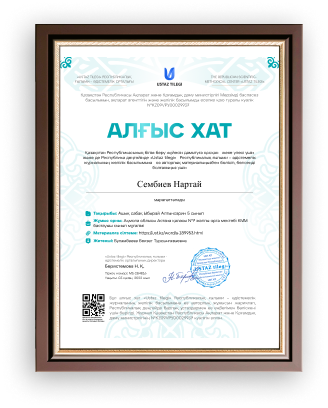

Head of department
Computer science and art
_____________ ?????
|
10.1A Computer networking and information security |
School: school number 28 |
||
|
Date: |
Teacher Name:
|
||
|
Grade: 10 |
Number present: |
absent: |
|
|
Lesson topic |
The principles of computer networks |
||
|
Learning objectives that are achieved in this lesson (link to the curriculum) |
10.6.1.4 explain the purpose of a private virtual network
|
||
|
Lesson objectives |
Understand how and why VPN is used |
||
|
Evaluation Criteria |
Knowledge, understanding be able to understand how VPN is used; |
||
|
Language objective |
Language learning objectives Students can: orally describe the purpose and performance VPN; To use English terms while explaining. Subject vocabulary and terminology
|
||
|
Instilling values
|
Value in accordance with the national idea "Mangilik el":
The instilling of values is carried out through a dialogue on academic integrity, cooperation through group work, functional literacy through practical tasks. |
||
|
Interdisciplinary Communication |
English |
||
|
Preliminary knowledge |
Spatial thinking |
||
|
Planned timings |
Planned activities (replace the notes below with your planned activities) |
Resources |
||
|
Starter 0–7 min |
Organizational moment: checking those present in the journal. Frontal conversation on previously studied issues: 1. What is a computer network? 2. What are the types of computer networks? 3. What networks are called global? 4. What is a server? 5. What is the Internet? 6. What network services do you know?
Preparing students for learning new knowledge Expand the lesson topic through the question “How do computers find each other on the network? (posing the problem) ” Groups should offer their ideas.
Acquaintance of students with the topic of the lesson and its objectives |
|
||
|
7-15 min |
Virtual private networks – VPN VPN – Virtual Private Network – simulate the capabilities of a private network within the public, using the existing infrastructure. The peculiarity of VPN is the formation of logical connections regardless of the type of physical environment. Allow you to do without the use of dedicated channels. The history of the origin of VPN goes back to the 60s of the last century, when the specialists of the engineering Department of the new York telephone company developed a system of automatic connection of PBX subscribers – Centrex (Central Exchange).
|
Slide 2-3 |
||
|
15-20min |
Practical task The division of group into 3 subgroups to search for information about the classification of a VPN, after the separation of this information Pupils rate themselves according to the principle of self-assessment according to the principle of academic integrity.
|
Slide 4-5
|
||
|
15-25 min |
Basic VPN components VPN gateway – a network device connected to several networks, performs the functions of encryption, identification, authentication, authorization and tunneling. It can be solved both software and hardware. The VPN client (host) can be solved programmatically. Performs encryption and authentication functions. The network can be built without using VPN clients. A tunnel is a logical connection between a client and a server. In the process of implementing the tunnel uses methods of information protection. An edge server is a server that is external to the corporate network. Such a server can be, for example, a firewall or a NAT system. VPN information security – a number of measures to protect corporate network traffic when passing through the tunnel from external and internal threats.
|
Slide 6 |
||
|
25-30 min |
The pattern of interaction between provider and client User scheme – the equipment is located on the territory of the client, methods of information security and QoS are organized independently. Provider scheme – VPN facilities are placed in the provider's network, methods of information security and QoS are organized by the provider. Mixed scheme – used when the client interacts with several providers. |
Slide 7-12 |
||
|
30-35 min |
VPN data protection Requirements for a secure channel:
Comparative characteristics of VPN protocols |
Slide 13-16 |
||
|
35-40 min |
Reflection. |
|
||
|
Differentiation – how do you plan to give more support? How do you plan to challenge the more able learners? |
Assessment – how are you planning to check students’ learning? |
Cross-curricular links |
||
|
|
|
Observe SE throughout the lesson when moving around the classroom during group work. |
||
|
Reflection Were the lesson objectives/learning objectives realistic? What did the learners learn today? What was the learning atmosphere like? Did my planned differentiation work well? Did I stick to timings? What changes did I make from my plan and why? |
Use the space below to reflect on your lesson. Answer the most relevant questions from the box on the left about your lesson. |
|||
|
Summary evaluation What two things went really well (consider both teaching and learning)? 1: Questioning students, everybody involved 2: All students actively involved, lots of easy questions so more challenged students able to get involved. What two things would have improved the lesson (consider both teaching and learning)? 1: Incorporate a game to find the information What have I learned from this lesson about the class or individuals that will inform my next lesson? Have a wide range of questions from easy to difficult for differentiation. |
||||
жүктеу мүмкіндігіне ие боласыз
Бұл материал сайт қолданушысы жариялаған. Материалдың ішінде жазылған барлық ақпаратқа жауапкершілікті жариялаған қолданушы жауап береді. Ұстаз тілегі тек ақпаратты таратуға қолдау көрсетеді. Егер материал сіздің авторлық құқығыңызды бұзған болса немесе басқа да себептермен сайттан өшіру керек деп ойласаңыз осында жазыңыз
The principles of computer networks
The principles of computer networks

Head of department
Computer science and art
_____________ ?????
|
10.1A Computer networking and information security |
School: school number 28 |
||
|
Date: |
Teacher Name:
|
||
|
Grade: 10 |
Number present: |
absent: |
|
|
Lesson topic |
The principles of computer networks |
||
|
Learning objectives that are achieved in this lesson (link to the curriculum) |
10.6.1.4 explain the purpose of a private virtual network
|
||
|
Lesson objectives |
Understand how and why VPN is used |
||
|
Evaluation Criteria |
Knowledge, understanding be able to understand how VPN is used; |
||
|
Language objective |
Language learning objectives Students can: orally describe the purpose and performance VPN; To use English terms while explaining. Subject vocabulary and terminology
|
||
|
Instilling values
|
Value in accordance with the national idea "Mangilik el":
The instilling of values is carried out through a dialogue on academic integrity, cooperation through group work, functional literacy through practical tasks. |
||
|
Interdisciplinary Communication |
English |
||
|
Preliminary knowledge |
Spatial thinking |
||
|
Planned timings |
Planned activities (replace the notes below with your planned activities) |
Resources |
||
|
Starter 0–7 min |
Organizational moment: checking those present in the journal. Frontal conversation on previously studied issues: 1. What is a computer network? 2. What are the types of computer networks? 3. What networks are called global? 4. What is a server? 5. What is the Internet? 6. What network services do you know?
Preparing students for learning new knowledge Expand the lesson topic through the question “How do computers find each other on the network? (posing the problem) ” Groups should offer their ideas.
Acquaintance of students with the topic of the lesson and its objectives |
|
||
|
7-15 min |
Virtual private networks – VPN VPN – Virtual Private Network – simulate the capabilities of a private network within the public, using the existing infrastructure. The peculiarity of VPN is the formation of logical connections regardless of the type of physical environment. Allow you to do without the use of dedicated channels. The history of the origin of VPN goes back to the 60s of the last century, when the specialists of the engineering Department of the new York telephone company developed a system of automatic connection of PBX subscribers – Centrex (Central Exchange).
|
Slide 2-3 |
||
|
15-20min |
Practical task The division of group into 3 subgroups to search for information about the classification of a VPN, after the separation of this information Pupils rate themselves according to the principle of self-assessment according to the principle of academic integrity.
|
Slide 4-5
|
||
|
15-25 min |
Basic VPN components VPN gateway – a network device connected to several networks, performs the functions of encryption, identification, authentication, authorization and tunneling. It can be solved both software and hardware. The VPN client (host) can be solved programmatically. Performs encryption and authentication functions. The network can be built without using VPN clients. A tunnel is a logical connection between a client and a server. In the process of implementing the tunnel uses methods of information protection. An edge server is a server that is external to the corporate network. Such a server can be, for example, a firewall or a NAT system. VPN information security – a number of measures to protect corporate network traffic when passing through the tunnel from external and internal threats.
|
Slide 6 |
||
|
25-30 min |
The pattern of interaction between provider and client User scheme – the equipment is located on the territory of the client, methods of information security and QoS are organized independently. Provider scheme – VPN facilities are placed in the provider's network, methods of information security and QoS are organized by the provider. Mixed scheme – used when the client interacts with several providers. |
Slide 7-12 |
||
|
30-35 min |
VPN data protection Requirements for a secure channel:
Comparative characteristics of VPN protocols |
Slide 13-16 |
||
|
35-40 min |
Reflection. |
|
||
|
Differentiation – how do you plan to give more support? How do you plan to challenge the more able learners? |
Assessment – how are you planning to check students’ learning? |
Cross-curricular links |
||
|
|
|
Observe SE throughout the lesson when moving around the classroom during group work. |
||
|
Reflection Were the lesson objectives/learning objectives realistic? What did the learners learn today? What was the learning atmosphere like? Did my planned differentiation work well? Did I stick to timings? What changes did I make from my plan and why? |
Use the space below to reflect on your lesson. Answer the most relevant questions from the box on the left about your lesson. |
|||
|
Summary evaluation What two things went really well (consider both teaching and learning)? 1: Questioning students, everybody involved 2: All students actively involved, lots of easy questions so more challenged students able to get involved. What two things would have improved the lesson (consider both teaching and learning)? 1: Incorporate a game to find the information What have I learned from this lesson about the class or individuals that will inform my next lesson? Have a wide range of questions from easy to difficult for differentiation. |
||||

шағым қалдыра аласыз















